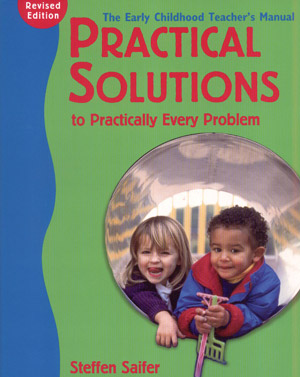ExchangeEveryDay Past Issues
 << Previous Issue
| View Past Issues | | Next Issue >>
<< Previous Issue
| View Past Issues | | Next Issue >> Too Noisy, Too Boistrous
February 11, 2013
To the one who knows how to look and feel, every moment of this free wandering life is an enchantment.
-Alexandra David-Neel
-Alexandra David-Neel
- Establish a classroom rule that only quiet voices can be used inside the classroom. Demonstrate what a quiet voice sounds like...
- Provide more activities with more challenges to keep children's interest high.
- Put number limits on the noisiest areas, at least temporarily.
- Encourage children who are playing appropriately by saying something like: "Thank you for using a quiet voice. It helps make the room a pleasant place for everyone to work."
- If there are two children who tend 'to get each other going' when they play together, guide them into separate activities at the beginning of free choice.
 Find solutions quickly and easily! This updated classic offers hundreds of tested solutions for the tricky problems, questions, and concerns that are part of every early childhood teacher's day. New topics include:
Find solutions quickly and easily! This updated classic offers hundreds of tested solutions for the tricky problems, questions, and concerns that are part of every early childhood teacher's day. New topics include:
- Working with English-language learners
- Helping children deal with traumatic life events
- Assessment and accountability
- Working with mixed-age groups
- Using computers in the classroom
Each chapter also includes an updated resource list, as well as a list of web-based resources. For beginning and experienced teachers alike, this "how-to" book on classroom management is like having your own counselor in the classroom.




Comments (11)
Displaying All 11 CommentsModesto, CA, United States
When children are noisy during active learning making noise is pretty much inevitble.
ece consultant
Dallas, TX, United States
My classroom was always noisy during worktime/playtime. The children were actively engaged. And I had 25 children and me back in the day, 1980's, so when I was actively engaged with them, the noise made sense.
United States
"Indoor voice" is a good phrase to use as well as quiet voice.
One of my teachers once told a parent the she was trying to her son learn to use his indoor voice. The mom replied…"He has never had one."
HighScope Foundation
Ypsilanti, MI, United States
Noisy and boisterous play is not inherently “bad” and can in fact be a sign that children are actively and enthusiastically involved in their activities. It is important to differentiate between aimless and loud running around the classroom, and purposeful play that is accompanied by excited voices. Rather than an abstract and blanket rule about using quiet voices indoors, if children are making too much noise for someone to hear what another person is saying, simply say so. This is a reasonable and concrete request, tied to the immediate situation. The reason to provide children with interesting and challenging activities is to prevent boredom and promote learning, not to keep their voices down. Limiting the number of children who can play in an area is arbitrary and discourages initiative. Instead, problem-solve with the children on how to expand the space and/or use it in a way that can accommodate the full number of players. Rather than thanking children for using a quiet voice (which is aimed at pleasing adults rather than facilitating children’s learning), respond to the children’s enthusiasm in an appropriate voice and show how much you enjoy playing and partnering with them.
retired
San Diego, CA, United States
Before teachers take this advice they should watch the video from Margie Carter called "Setting Sail." What is too noisy and boisterous for most teachers, may just be enthusiasm and engagement for the children.
Or you could take some outside to be noisy and boisterous...
Spirit Child Yoga and ECE
Aurora, ON, Canada
What! Sure, inside voices inside. But the children are telling you something! They need boisterous play! You should continue to promote quotes from Big Body Play by Frances M. Carlson. We women have a bad reputation on cutting out a very important part of children's development by cutting out the play that children need. And limiting the number of children who can play in a centre simply strips them of the ability to problem-solve, self-regulate, and learn to get along in a group. Thanks for giving us all something to talk about! Let those kids get active and loud, and then help them learn to calm themselves down!
Shining Stars
Suamico, WI, United States
I agree with Patricia. We know that boys in particular need active play. Dan Hodgins says it best. To paraphrase, "We insist that the library be a quiet area yet we know that many boys will avoid that area just for that reason, On the other hand we wonder why boys have traditionally been less proficient readers." I think inside voice needs to go away.
Little Pals
Fairfield, Ca, United States
I was excited when I read the title - wow, I thought, now I'll know how to reduce the noise level in my family child care, especially when all five enrolled 5 children are present. Ha! I was sooo disappointed. The suggestions may be effective in a large center, but in a family home? Please. Every day I acknowledge those who play with quiet, indoor voices. Each child, with the exception of the youngest who is just 13 months old, knows the difference between loud and quiet, yet when the group dynamics take over, the sound can become deafening.
Any practical suggestions for those of us on the real front lines of child care? We go outside at least twice a day, sometimes more often. When the children come in, after playing for two hours or more in my park-like backyard, they still have tremendously high energy. We've done pre-school aerobics indoors and those who are old enough do projects, but ... free time is really too loud. The ONLY thing that quiets them is an interesting video, such as Milo and Otis, or Richard Scary's ABC's or the wonderful video by LeapFrog, The Letter Factory. And when these movies are on, I still with the children and comment on what they're seeing - that makes our conversations, following the program, about what they saw, much easier.
I'd just like other ideas!!
NORWESCAP Child & Family Resource Services
Newton, NJ, United States
Patricia Reinhardt- My thoughts exactly! Thank you
Consultant/Professor
Newtown, CT, United States
We need to stop thinking that noisy and boisterous are unacceptable.
Children are often communicating something important in this behavior - and it is not that they need more controls and restrictions on their play - it is that they need to be moving and engaging in vigorous activity. Dividing children from their friends and limiting how many can play together seems to better serve the teacher than the children - who need to learn to play cooperatively and with self-regulation.
I-Care, Inm Head Start
Statesville, North Carolina, United States
I really do appriciate this article. Being this is the time of the year children are quick to get restless and we have more inclement weather. Very good advice that I will be using in the classroom....Thank you.
Post a Comment